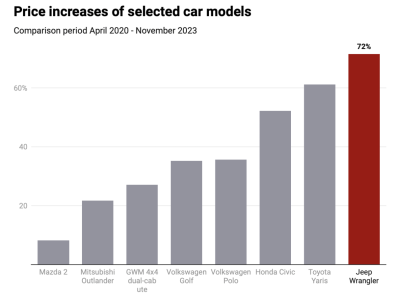Finding a reasonably priced new car is almost impossible. And the second hand market is not much better
- Replies 1

Studio Romantic/Shutterstock
Despite most businesses around the world returning to some form of normal after the pandemic, supply chain problems continue to disrupt the manufacturing and availability of new and second hand cars.
This disruption has caused vehicle prices to sky-rocket, adding to cost-of-living pressures already being experienced by most Australians.
Car prices in Australia rose throughout 2023 with an average increase of almost 20% since April 2020, even faster than the consumer price index.
The increase has varied depending on the model, but the biggest increases – of about 25% – have been in the small car sector.
This resembles the situation in Europe where the prices of the cheapest models produced by the five biggest carmakers have increased by an average of 41% since 2019.
The impact of supply not matching demand
The availability and cost of buying new cars in Australia have been impacted by both demand and supply issues.
On the demand side, many new orders have been delayed by time lost during the lockdowns followed by strict social distancing requirements holding up work at all stages of the manufacturing process.
This has been worsened by new car demand increasing across all markets. In Europe, new vehicle registrations rose 11% in October 2023 for 14th consecutive month. The Federal Chamber of Automotive Industries in Australia also recorded breaking new vehicles sales in August 2023 with 15.4% increase compared to the same period in 2022.
There has also been an ongoing global shortage of semiconductors to make computer chips. Not only are these chips commonly used in household devices, they are essential as cars are increasingly automated and electric vehicles become popular.
Geopolitical tensions
The shortage and associated hold ups, has been exacerbated by conflict in the Middle East, particularly the Israel-Hamas war as Israel is a major supplier of chips to the world.
Shipping delays caused by the need to re-route car carriers due to attacks by Houthi rebels on ships operated by supporters of Israel in the conflict have also held up supply.
A shortage of the special RORO (roll on, roll off) shipping carriers used to transport cars has added to delays. While demand for car carriers has grown 37% since 2019, the fleet has barely grown.

A shortage of RORO (roll on, roll off) carriers is contributing to delays in new car supplies. Avigator/Fortuna/Shutterstock
Problems at the Australian end
When shipments do finally arrive at the Australian ports, they face port congestion. This is caused by several factors:
- large amounts of cargo arriving at Australian ports and terminals at the same time as previously delayed exports are being sent offshore
- higher demand for quarantine checks after pests and seeds were found in 1000s of vehicles being brought in from Asia and Europe last year
- insufficient labour to conduct biosecurity checks and handle cargo
- industrial action, such as the ongoing dispute at DP World-operated ports, affecting productivity.
A second hand solution?
Understandably, when there is a shortage of new cars and prices are high, consumers have turned to second-hand cars which are already in the country. However, this has led to a supply-demand imbalance, reducing the availability and increasing the cost of this once cheaper option.
The longer the wait for new cars and the higher the costs, the greater the pressure on the second-hand car market.
Some strategic customers may worsen the problem by registering to buy several different cars and then only buying the first one that arrives, therefore jacking up the demand and slowing down the process. They may also demand a high price for their used car, putting a vehicle out of reach for some would-be buyers.
It will take time to resolve
Supply will gradually catch up with demand, therefore easing the problem. But the current global geopolitical tensions and industrial action on the wharves, makes it difficult to predict when this will happen.
In the short term, the Albanese government may need to intervene to deter unhealthy trading practices. This could be achieved in the short term by imposing higher taxes on people who register to buy more cars than they need for personal use.
This article was first published on The Conversation, and was written by , Vinh Thai, Professor, RMIT University









